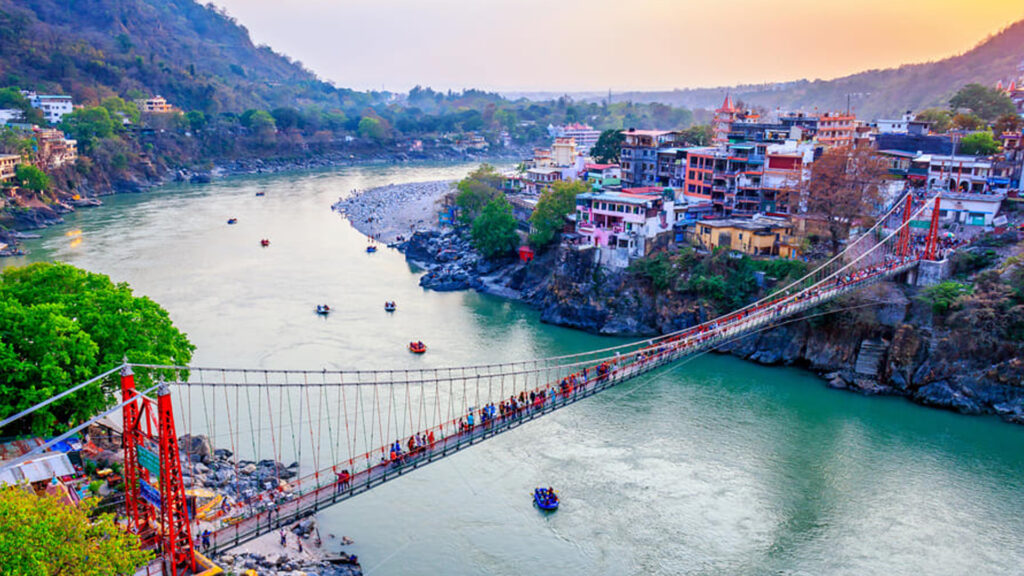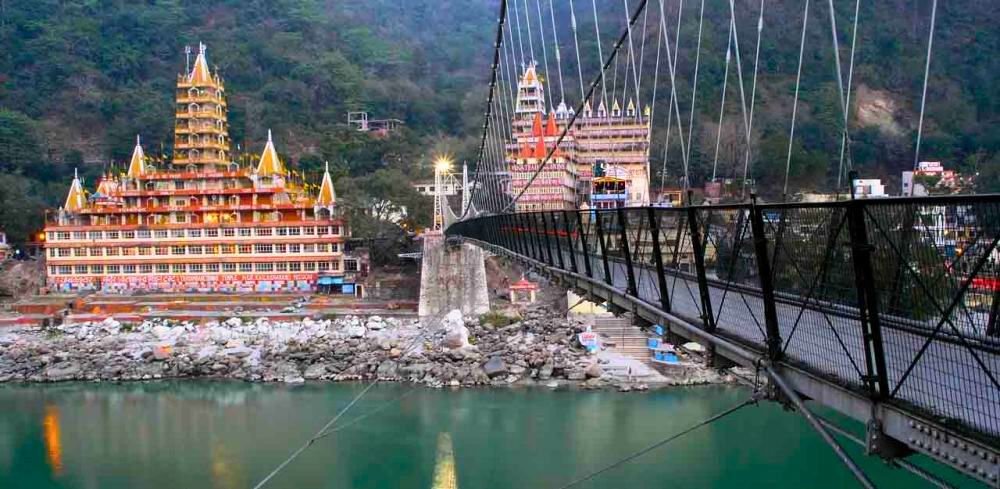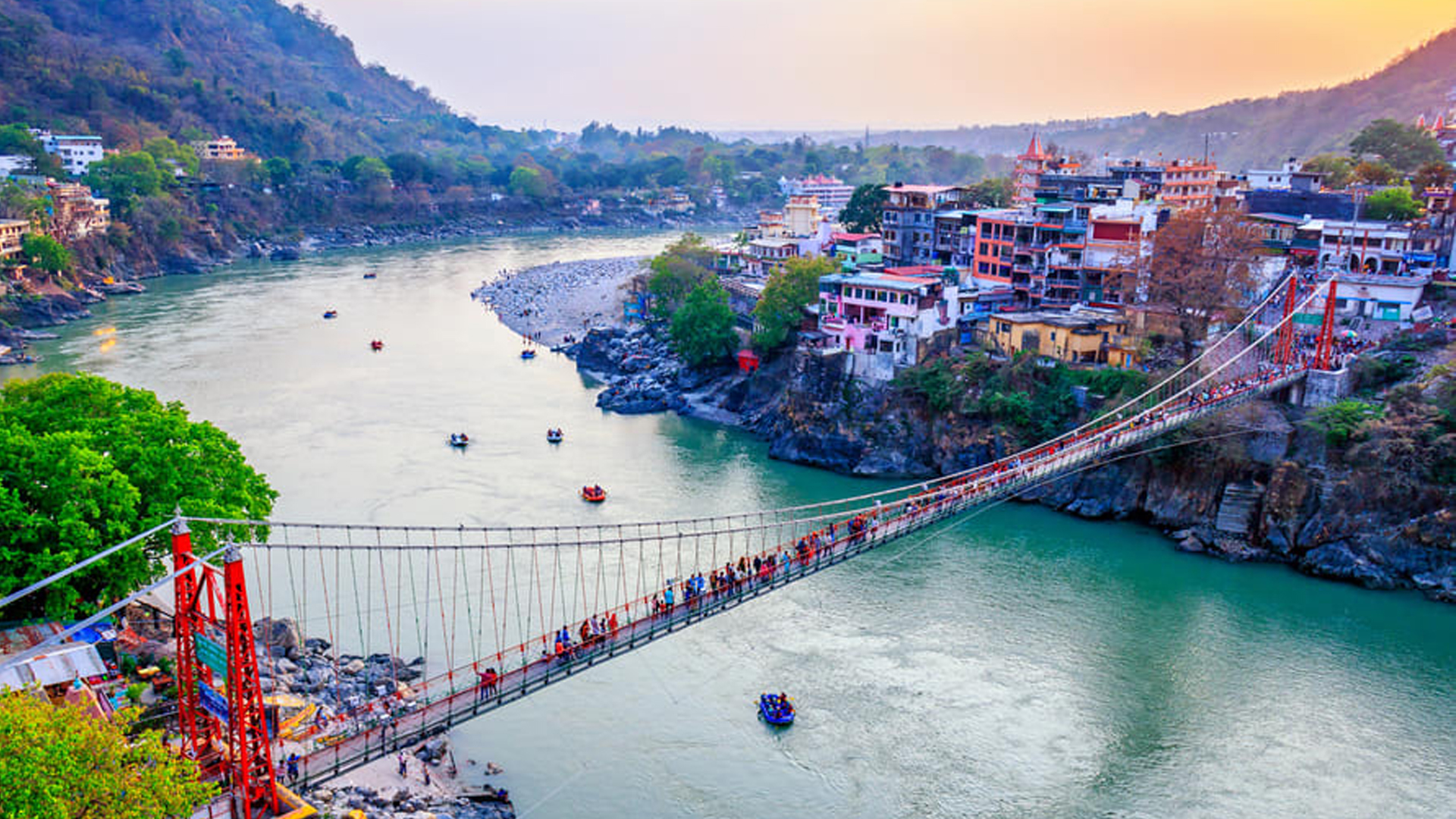Laxman Jhula: A Historic Icon of Rishikesh
Introduction
Laxman Jhula is one of the most iconic landmarks in Rishikesh, Uttarakhand. This suspension bridge over the holy River Ganga holds immense historical, religious, and cultural significance. It is not just a means of crossing the river but also a symbol of the town’s spiritual aura and architectural brilliance. The bridge connects the villages of Tapovan in Tehri Garhwal and Jonk in Pauri Garhwal, serving as an essential link for locals, pilgrims, and tourists alike.
Historical Background
The origins of Laxman Jhula date back to ancient times. According to Hindu mythology, it is believed that Laxman, the younger brother of Lord Rama, crossed the Ganges at this spot using a rope bridge. This event connects the bridge to the great Hindu epic Ramayana, making it a site of religious importance.
The modern structure, however, was built much later, in 1929, after the original rope bridge was washed away due to floods. The bridge was constructed with the support of the then-government to facilitate movement across the river. Since then, Laxman Jhula has been an integral part of Rishikesh’s heritage, attracting millions of visitors every year.
Architectural Significance
Laxman Jhula is a suspension bridge made of iron and steel cables, spanning approximately 137 meters (450 feet) in length and standing 21 meters (70 feet) above the river. The design follows the principles of suspension bridges, where the weight is distributed across cables anchored to strong towers at both ends.
One of the remarkable aspects of Laxman Jhula’s construction is its ability to withstand harsh weather conditions and continuous foot traffic. Despite being almost a century old, it remained sturdy and functional for decades. However, due to structural concerns, authorities restricted its usage and eventually closed it for vehicles and heavy movement in 2019.

Religious and Cultural Significance
Laxman Jhula is not just a bridge but a sacred pilgrimage site. Since it is believed to be associated with Laxman, many devotees visit it with reverence. Several temples are located near the bridge, reinforcing its spiritual aura. Some notable ones include:
- Laxman Temple: Situated at one end of the bridge, this temple is dedicated to Laxman and is believed to be on the spot where he meditated after crossing the Ganga.
- Tera Manzil Temple: Also known as the Trimbakeshwar Temple, this multi-story temple is one of the most significant in Rishikesh, housing various Hindu deities.
- Shatrughna Temple: Dedicated to Shatrughna, another brother of Lord Rama, this temple adds to the mythological relevance of the area.
Apart from religious devotees, Laxman Jhula is also a hotspot for yoga practitioners, spiritual seekers, and adventure enthusiasts. The presence of numerous ashrams, yoga centers, and meditation retreats around the bridge contributes to Rishikesh’s reputation as the “Yoga Capital of the World.”
Impact on Tourism
Laxman Jhula has long been a central attraction for tourists visiting Rishikesh. Travelers from around the world come to experience its unique blend of history, spirituality, and scenic beauty. The bridge offers breathtaking views of the Ganges, especially during sunrise and sunset. The presence of vibrant markets, cafes, and local eateries on both sides of the bridge adds to its charm.
Many adventure sports activities, including river rafting, bungee jumping, and trekking, are also organized near Laxman Jhula, attracting thrill-seekers. Photographers and travel bloggers find it an ideal spot to capture the essence of Rishikesh.
Laxman Jhula is generally safe for couples. It is a popular tourist attraction where people of all backgrounds, including couples, frequently visit. The surrounding area has a peaceful and spiritual atmosphere, with cafes, temples, and scenic views, making it an ideal spot for couples to explore. However, since the bridge was closed for structural reasons in 2019, visitors should check the latest updates about its accessibility. If you’re visiting in the evening, it’s advisable to stay in well-lit areas and avoid secluded spots for safety.
Challenges and Restoration Efforts
Over the years, Laxman Jhula has faced several challenges, including:
- Structural Deterioration: With increasing foot traffic and weather-related wear and tear, the bridge showed signs of damage.
- Safety Concerns: In 2019, experts deemed it unsafe for heavy use, leading to restrictions on its usage.
- Environmental Impact: The growing number of tourists and urbanization around the bridge have raised concerns about pollution and ecological imbalance.
To address these issues, the Uttarakhand government announced the construction of a new, stronger bridge near the existing one. While preserving the old Laxman Jhula’s legacy, the new bridge aims to ensure safer and smoother connectivity for locals and tourists.


Nearby Attractions
In addition to Laxman Jhula, Rishikesh offers several other fascinating attractions:
- Ram Jhula: Another iconic suspension bridge located a few kilometers downstream, connecting Swarg Ashram with Sivananda Ashram.
- Parmarth Niketan Ashram: A famous spiritual retreat known for yoga, meditation, and the renowned Ganga Aarti.
- The Beatles Ashram (Chaurasi Kutia): A historic site where The Beatles stayed in the 1960s, now a meditation and photography hotspot.
- Neelkanth Mahadev Temple: A revered temple dedicated to Lord Shiva, located amidst the lush Himalayan forests.
- Triveni Ghat: A significant ghat along the Ganges, known for its mesmerizing evening Ganga Aarti.
- Kunjapuri Temple: A scenic temple located on a hilltop, offering panoramic sunrise views over the Himalayas.
For more information about nearby attractions you can visit : click here
Laxman Jhula is famous in Rishikesh for several reasons:
- Religious Significance – It is believed to be the spot where Laxman, the brother of Lord Rama, crossed the River Ganga using a rope bridge, making it a sacred site for Hindus.
- Historical Importance – The present iron suspension bridge was built in 1929, replacing the old rope bridge, and has since become an iconic structure.
- Architectural Marvel – Its suspension design over the Ganga provides breathtaking views and an architectural spectacle.
- Spiritual and Yoga Hub – The area around Laxman Jhula is filled with temples, ashrams, and yoga centers, attracting spiritual seekers from around the world.
- Tourist Attraction – The bridge and its surroundings offer scenic beauty, adventure activities like river rafting, and vibrant markets, making it a must-visit destination.
FAQs about Laxman Jhula
Q1: Why is Laxman Jhula famous?
Laxman Jhula is famous for its mythological significance, as it is believed that Laxman, the brother of Lord Rama, crossed the Ganga here. It is also known for its stunning views, temples, and spiritual atmosphere.
Q2: Is Laxman Jhula open to the public?
As of recent updates, Laxman Jhula has been closed for heavy movement due to structural concerns, but pedestrians can still visit and explore the surrounding areas.
Q3: What is the difference between Laxman Jhula and Ram Jhula?
Laxman Jhula is an older suspension bridge with mythological ties to Laxman, while Ram Jhula, located nearby, is a newer and larger bridge that connects Swarg Ashram to Sivananda Ashram.
Q4: What are the top attractions near Laxman Jhula?
Nearby attractions include Ram Jhula, Parmarth Niketan Ashram, The Beatles Ashram, Neelkanth Mahadev Temple, Triveni Ghat, and Kunjapuri Temple.
Q5: Can I do adventure activities near Laxman Jhula?
Yes, activities such as river rafting, bungee jumping, trekking, and camping are available in the surrounding areas.
Conclusion
Laxman Jhula is more than just a bridge; it is a historical and cultural landmark that has stood the test of time. Its deep roots in Hindu mythology, its spiritual importance, and its role in facilitating connectivity make it one of the most significant attractions in Rishikesh. Whether for religious devotion, spiritual enlightenment, or sheer adventure, Laxman Jhula offers something for everyone.
The bridge has played a vital role in tourism, attracting visitors from around the world who seek to experience the unique blend of heritage and modernity that Rishikesh offers. Its closure due to safety concerns was a setback, but with planned restoration and the construction of a new bridge, the essence of this landmark will continue to thrive.
Preserving historical landmarks like Laxman Jhula is crucial for maintaining the cultural and religious fabric of India. Efforts to restore and maintain such sites ensure that future generations can continue to experience their historical, spiritual, and aesthetic significance. As Rishikesh evolves, the legacy of Laxman Jhula will remain a testament to the town’s rich heritage, offering inspiration and wonder to all who visit.




Leave a Reply